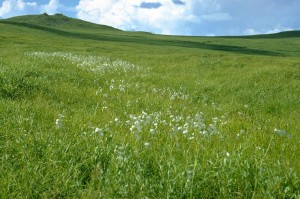In some circles turfgrass is considered a water waster thus a thing to be eliminated. There is contrary opinion speaking to the benefits of turfgrass. Both sides have good points and there is ample room for compromise.
America currently has well more than an estimated 30 million acres of cultivated turfgrass. Many many more of wild turfgrass. Lawns provide aesthetic quality of life enhancements that brings pride to communities and maintains property values. Turfgrass also provides many environmental benefits.
James Beard Ph.D at the International Sports Turf Institute says humans have been using turfgrass for enhancement of their environment for more than 10 centuries.
The Benefits of Turfgrass
Erosion/Run-Off Control
Turfgrass will retain rainwater. As water is held, it has more time to infiltrate into the soil. Run-off of what remains will be greatly slowed if not eliminated entirely. This helps the suburban wastewater management problem most older cities are facing.
The grass roots bind the soil which reduces erosion. Over 6 billion tons of top soil is eroded away every year with an economic cost over $6 billion. Erosion experts say the intense root system of turfgrass is the best erosion control method.
Turf also works well as an interceptor for run-off coming off paved areas. Hard surface run-off carries with it a lot of bad chemicals and compounds. Turfgrass can infiltrate the water into the soil and allow natural processes to digest the contaminants we don’t want in our water supply.
The Maryland Agricultural Statistics Service (MASS) says there is no other plant matching the bio degenerative capabilities as a healthy stand of turfgrass. In fact turfgrass is used to clean effluent water irrigated onto it.
Ground Water Recharge
By holding onto rain water and establishing a healthy soil environment, turfgrass provides excellent soil conditions for deep percolation of water back into our ground based water systems.
Organic Compound Bio-degeneration
Healthy turf will support soil with excellent qualities for microbes. A perfect environment to digest all sorts of materials into harmless if not beneficial soil components.
Carbon Sequester
Carbon is blamed for climate change. MASS estimates say turfgrass can sequester up to 37 billion tons of carbon every year. All plant material will convert carbon gases, such as carbon dioxide, into beneficial discharges of oxygen. Turfgrass happens to very good at it.
One acre of turf will absorb hundreds of pounds of sulfur dioxide each year. Also hydrogen fluoride and peroxyacetyl nitrate, the worst of the air pollutants.
Dust Control
The Maryland Agricultural Statistics Service (MASS) says turfgrass in the U.S. traps 12 million tons of dust. Dust is organically digested and returned to the soil. Grassed areas have measurably less dust in the air.
Heat Dissipation
Turfgrass dissipate heat by using some the sun’s energy for photosynthesis, but also by acting as evaporative coolers. Heat is dissipated as water transpires from the leaf mass.
Temperature measurements show dramatic differences between turf and other surface coverings. Turf is typically 10-14 degrees cooler than pavement. This why urban areas tend to be 9 to 12 degrees warmer than surrounding suburban or rural areas.
The front lawns of 8 typical suburban homes will produce up to 70- tons worth of air conditioning on a typical summer day. An argument can be made turf’s cooling effect may result in significant electricity savings on hot sunny days.
Oxygen Creation
Turfgrass like all plants releases oxygen into the atmosphere as a byproduct of photosynthesis. The amount of oxygen cannot be ignored.
Examples: a 55 square foot patch of healthy turfgrass will release enough oxygen to support a human for a day. A 50’x 50’ section will provide enough for 4 people per day. An acre produces enough for 64 people! The grass and other vegetation along our interstate system produce enough oxygen for 22 million people. Numbers are from MASS.
Security
Lawns are commonly used to created “zones of high visibility” to thwart sneaky evil-doers. In fire prone areas lawns are used as fire breaks around structures.
Quality of Life- Enjoyment
Plain simple fact, people enjoy healthy turf. Whether for its beauty or for its use. Sports and outdoor living just aren’t the same without turfgrass.
Quality of Life- Health
Ever see a study about humans and nature where people didn’t obtain significant benefit being around living creatures? Well there aren’t any. We do better when other living things are around us. Turfgrass alone or as part of a landscape makes people feel and perform better.
Property Value
University studies have shown people are attracted to properties with nice landscapes.
For residential properties it has meant a 10-20% property value increase at time of sale. For commercial properties, the value or prosperity of the business are affected by the “looks” of their property. The landscape becomes a serious component of the company’s brand.
Noise Abatement
Turf dampens noise. Grassed slopes above a highway will reduce noise by 8-10 decibels. Use of shaped grassed slopes and landscaping is helping airports cut their noise levels.
Soil Health
As already mentioned, grass helps trap, process, and return to the soil dusts, gasses, and other airborne contaminants. The soil and air quality are enhanced. Grass root drastically reduce erosion and aerify the soil. Water infiltration and percolation is improved. All of this helps improve and maintain healthy soil environments.
An easy soil health indicator is the population of earthworms. A good target is between 200 and 300 per square meter. Earthworms are key to for strong soil health. Turfgrass is key for healthy earthworm populations.
So turfgrass is a gift that gives back in many ways. The trick is to manage it properly. Advances with irrigation help us enjoy turf without being an environmental or water “wasting” problem.












Where I live, there are very few homes that have good looking grass out front. I know that it is due to the naturally dry climate and the colder months approaching. Come the spring, I’ll see about getting some of this turf to help my grass out. Like you said, it can greatly help the natural grass by improving the health of the soil.
Thanks for sharing this post about turfgrass. I hadn’t thought of grass as a tool to help cool your home in the summer. This is an interesting concept. I had no idea that a lawn could produce 70 tons of AC! That is a huge deal. Thanks for the post!
Coupled with all the other benefits, turfgrass comes out as a really cool (no pun intended) landscape feature!